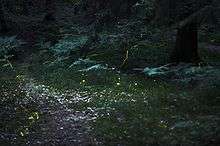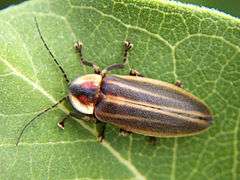Crepuscular
| Look up crepuscular in Wiktionary, the free dictionary. |
Crepuscular animals are those that are active primarily during twilight (i.e., the period immediately after dawn and that immediately before dusk). It is thus to be distinguished from diurnal and nocturnal behavior where an animal is active during the hours of daylight or the hours of darkness respectively. The term is not precise, however, as some crepuscular animals may also be active on a moonlit night or during an overcast day. The term matutinal is used for animals that are only active before dawn, and vespertine for those only active after sunset.
The time of day an animal is active depends on a number of factors. Predators need to link their activities to times of day at which their prey is available, and victims try to avoid the times when their principal predators are at large. The temperature at midday may be too high or at night too low, so for many varied reasons, crepuscular activity may best meet their requirements by compromise. Some creatures may adjust their activities depending on local competition.
Etymology and usage
The word crepuscular derives from the Latin crepusculum ("twilight").[1] Its sense accordingly differs from diurnal and nocturnal behavior, which respectively peak during hours of daylight and darkness. The distinction is not absolute however, because crepuscular animals may also be active on a bright moonlit night or on a dull day. Some animals casually described as nocturnal are in fact crepuscular.[2]
Special classes of crepuscular behaviour include matutinal (or "matinal") and vespertine, denoting species active only in the dawn or only in the dusk, respectively. Those that are active during both morning and evening twilight are said to have a bimodal activity pattern.
Adaptive relevance

The various patterns of activity are thought to be mainly antipredator adaptations, though some could equally well be predatory adaptations. Many predators forage most intensively at night, whereas others are active at midday and see best in full sun. Thus, the crepuscular habit may both reduce predation pressure, thereby increasing the crepuscular populations, and in consequence offer better foraging opportunities to predators that increasingly focus their attention on crepuscular prey until a new balance is struck. Such shifting states of balance are often found in ecology.
Some predatory species adjust their habits in response to competition from other predators. For example, the subspecies of short-eared owl that lives on the Galápagos Islands is normally active during the day, but on islands like Santa Cruz that are home to the Galapagos hawk, it is crepuscular.[3][4]
Apart from the relevance to predation, crepuscular activity in hot regions also may be the most effective way of avoiding heat stress while capitalizing on available light.
Occurrence of crepuscular behaviour

Many familiar mammal species are crepuscular, including some bats, hamsters, housecats, stray dogs,[5] rabbits, ferrets, guinea pigs and rats. Other crepuscular mammals include jaguars, ocelots, strepsirrhines, red pandas, bears, deer, moose, chinchillas, the common mouse, skunks, Australian wombats, wallabies, quolls, possums and marsupial gliders, spotted hyenas, bobcats, tenrecidae, capybaras, African wild dogs and sitatunga. Crepuscular birds include the common nighthawk, owlet-nightjar, chimney swift, American woodcock and spotted crake.
Many moths, beetles, flies, and other insects are crepuscular and vespertine.
See also
References
- ↑ Winn, Philip (2001). Dictionary of Biological Psychology. Taylor & Francis. ISBN 0-415-13606-7.
- ↑ "Crepuscular Summary". BookRags.com. 2010-11-02. Retrieved 2011-07-11.
- ↑ Frederick, Prince (2006-04-15). "Night herons in the day!". Metro Plus Chennai. The Hindu. Retrieved 15 January 2012.
- ↑ Merck, John. "The community of terrestrial animals". Field Studies II: The Natural History of the Galápagos Islands. University of Maryland Department of Geology. Retrieved 15 January 2012.
- ↑ The Ecology of Stray Dogs: A Study of Free-Ranging Urban Animals – Alan M. Beck – Google Books. Books.google.com. Retrieved 2012-04-13.


